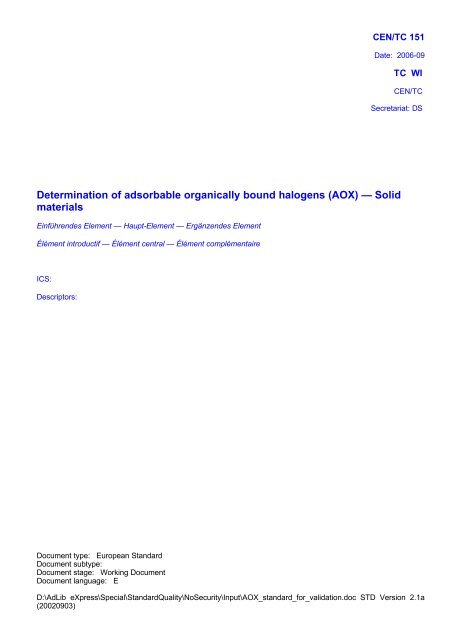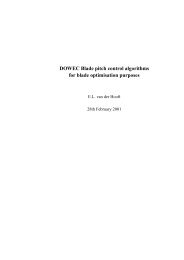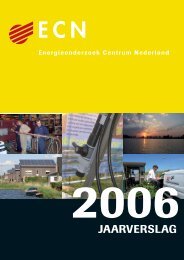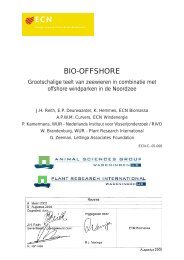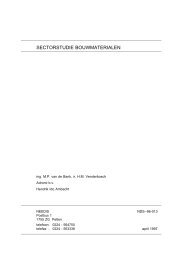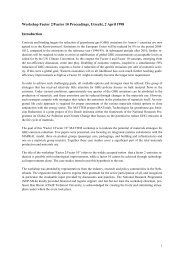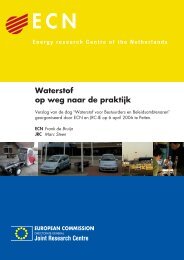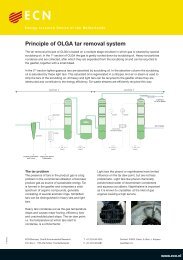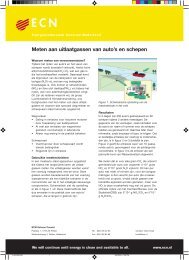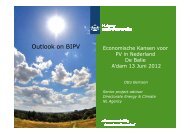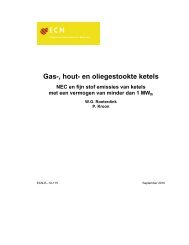CEN/TC - Ecn
CEN/TC - Ecn
CEN/TC - Ecn
Create successful ePaper yourself
Turn your PDF publications into a flip-book with our unique Google optimized e-Paper software.
Document type: European Standard<br />
Document subtype:<br />
Document stage: Working Document<br />
Document language: E<br />
<strong>CEN</strong>/<strong>TC</strong> 151<br />
Date: 2006-09<br />
<strong>TC</strong> WI<br />
<strong>CEN</strong>/<strong>TC</strong><br />
Secretariat: DS<br />
Determination of adsorbable organically bound halogens (AOX) — Solid<br />
materials<br />
Einführendes Element — Haupt-Element — Ergänzendes Element<br />
Élément introductif — Élément central — Élément complémentaire<br />
ICS:<br />
Descriptors:<br />
D:\AdLib eXpress\Special\StandardQuality\NoSecurity\Input\AOX_standard_for_validation.doc STD Version 2.1a<br />
(20020903)
<strong>TC</strong> WI :2003 (E)<br />
Contents Page<br />
1 Scope................................................................................................................................................5<br />
2 Normative references.......................................................................................................................5<br />
3 Definitions ........................................................................................................................................5<br />
4 Principle............................................................................................................................................5<br />
5 Interferences ....................................................................................................................................6<br />
6 Reagents...........................................................................................................................................6<br />
7 Apparatus .........................................................................................................................................7<br />
7.1 Apparatus for combustion and detection .......................................................................................7<br />
7.2 Equipment for adsorption................................................................................................................7<br />
7.3 Equipment for sample preparation..................................................................................................7<br />
8 Sampling and sample pre-treatment ...............................................................................................8<br />
8.1 Sampling...........................................................................................................................................8<br />
8.2 Sample pre-treatment.......................................................................................................................8<br />
9 Procedure.........................................................................................................................................8<br />
9.1 General .............................................................................................................................................8<br />
9.2 Adsorption and inorganic halide removal.......................................................................................8<br />
9.3 Combustion......................................................................................................................................9<br />
9.4 Initial calibration...............................................................................................................................9<br />
9.4.1 General .............................................................................................................................................9<br />
9.4.2 Calibration of the entire system ......................................................................................................9<br />
9.4.3 Check of argentometric measuring device ...................................................................................10<br />
9.5 Recalibration ..................................................................................................................................11<br />
9.6 Blank determination.......................................................................................................................11<br />
9.7 Quality Assurance of the overall procedure .................................................................................11<br />
9.7.1 Duplicate determination.................................................................................................................11<br />
10 Expression of results.....................................................................................................................11<br />
10.1 Method of calculation.....................................................................................................................11<br />
10.1.1 Entire system calibration (according to 9.4.2) ..............................................................................11<br />
10.1.2 Direct argentometric measurement device calibration (according to 9.4.3)................................12<br />
10.2 Expression of results.....................................................................................................................12<br />
11 Test report......................................................................................................................................12<br />
12 Performance characteristics..........................................................................................................12<br />
Annex A (informative) Precision data<br />
Annex B (informative) Storage of activated carbon<br />
Annex C (informative) Schematic diagram of an AOX apparatus<br />
Annex D (informative) List of matrices covered by this standard<br />
2<br />
EN 0000:2003
Foreword<br />
This document is a working document.<br />
<strong>TC</strong> WI :2003 (E)<br />
This document <strong>TC</strong> WI has been prepared by Technical Committee <strong>CEN</strong>/<strong>TC</strong> “BT/Task Force 151<br />
'HORIZONTAL'”, the secretariat of which is held by DS.<br />
This document has been prepared under a mandate given to <strong>CEN</strong> by the European Commission and the<br />
European Free Trade Association, and supports essentialrequirements of EU Directive(s).<br />
For relationship with EU Directive(s), see informative Annex D, which is an integral part of this document.<br />
Annex D will be added.<br />
The standard is applicable and validated for several types of matrices. The table below indicates which ones.<br />
Material Validated Document<br />
Soil ¨ [reference]<br />
Sludge ¨ [reference]<br />
Sediment ¨ [reference]<br />
3<br />
EN 0000:2003
<strong>TC</strong> WI :2003 (E)<br />
Introduction<br />
This document is developed in the project 'Horizontal'. It is the result of a desk study "Horizontal European<br />
standard for determination of AOX in sewage sludge and comparable matrices" in the project and aims at<br />
evaluation of the latest developments in assessing AOX in sludge, soil, treated biowaste and neighbouring<br />
fields. After discussion with all parties concerned in <strong>CEN</strong> and selection of a number of test methods described<br />
in this study the standard will be developed further as an modular horizontal method and validated in the<br />
project 'Horizontal'.<br />
Until now test methods determining properties of materials were often prepared in Technical Committees<br />
(<strong>TC</strong>s) working on specific products or specific sectors. In those test methods often steps as sampling,<br />
extraction, release or other processing, analyses, etc were included. In this approach it was necessary to<br />
develop, edit and validate similar procedural steps over and over again for each other product. Consequently<br />
this resulted in a lot of duplicate work. To avoid such duplication of work for parts of a testing procedure often<br />
was referred to parts of test methods from other <strong>TC</strong>s. However the following problems are often encountered<br />
while using references in this way: 1) The referenced parts are often not edited in a way that they could easily<br />
be referred to, 2) the referenced parts are often not validated for the other type of material and 3) the updates<br />
of such test standards on products might lead to inadequate references.<br />
In the growing amount of product and sector oriented test methods it was recognised that many steps in test<br />
procedures are or could be used in test procedures for many products, materials and sectors. It was supposed<br />
that, by careful determination of these steps and selection of specific questions within these steps, elements<br />
of the test procedure could be described in a way that can be used for all materials and products or for all<br />
materials and products with certain specifications.<br />
Based on this hypothesis a horizontal modular approach is being investigated and developed in the project<br />
'Horizontal'. 'Horizontal' means that the methods can be used for a wide range of materials and products with<br />
certain properties. 'Modular' means that a test standard developed in this approach concerns a specific step in<br />
a test procedure and not the whole test procedure (from sampling to analyses).<br />
The use of modular horizontal standards implies the drawing of test schemes as well. Before executing a test<br />
on a certain material or product to determine certain characteristics it is necessary to draw up a protocol in<br />
which the adequate modules are selected and together form the basis for the test procedure.<br />
The other horizontal modules that will be available in due time are to be found in the informative annex [xxx]<br />
which contains a brief overview of the modules that are or will be worked out in the project 'Horizontal.'<br />
The texts of the chapters 1 to 12 are normative; annexes are normative or informative, as stated in the top<br />
lines of the annexes.<br />
4<br />
EN 0000:2003
1 Scope<br />
<strong>TC</strong> WI :2003 (E)<br />
This European Standard describes an empirical method for the direct determination of organically bound<br />
chlorine, bromine and iodine (but not fluorine) adsorbed and occluded to the sample matrix. Non-volatile<br />
organically bound halogens adsorbable on activated carbon present in the aqueous phase of the sample prior<br />
to drying or adsorbed to sample surface are included in the determination.<br />
The standard is intended for analysis of solid material, for example sludge or soil in concentrations ranging<br />
from 5 mg/kg dry matter to approximately 6 g/kg dry matter. The exact concentration range covered depends<br />
on the instrument used. Matrices for which the standard has been validated are listed the foreword.<br />
2 Normative references<br />
This European Standard incorporates by dated or undated reference, provisions from other publications.<br />
These normative references are cited at appropriate places in the text and the publications are listed<br />
hereafter. For dated references, subsequent amendments to or revisions of any of these publications apply to<br />
this European Standard only when incorporated in it by amendment or revision. For undated references the<br />
latest edition of the publication referred to applies (including amendments).<br />
EN ISO 3696, Water for analytical laboratory use - Specification and test methods.<br />
TEMPORARY NOTE: The list of standards below will be updated once the correct numbers of Horizontal<br />
standards are available<br />
Horizontal standard 1.2-2, Sampling of sewage sludge and treated bio-wastes – Guidance on sampling<br />
techniques.<br />
Horizontal standard 1.2-3, Sampling of sludge, treated bio-wastes and soils in the landscape – Guidance on<br />
sampling soils in the landscape.<br />
Horizontal standard 1/3.33-2, Solid materials – Guidance for sample pre-treatment for determination of<br />
organic contamination of soil, sludges and treated biowaste.<br />
Horizontal standard 5.17-1, Solid materials – Determination of dry matter and water content on a mass basis –<br />
Gravimetric method.<br />
3 Definitions<br />
For the purpose of this European Standard, the following definition applies:<br />
3.1 adsorbable organically bound halogens (AOX): The equivalent amount of chlorine, bromine, and<br />
iodine contained in organic compounds, expressed as chloride when determined according to this European<br />
Standard.<br />
4 Principle<br />
Addition of activated carbon to dried, homogenised solid sample. Elution of inorganic halides and<br />
simultaneous adsorption of water soluble organic compounds on the activated carbon by shaking with<br />
acidified nitrate solution.<br />
Combustion of the loaded carbon / sample mixture in an oxygen stream.<br />
Absorption of the hydrogen halides produced followed by determination of the halide ions by an argentometric<br />
titration, such as microcoulometry. Expression of the result as the mass concentration of chloride.<br />
5<br />
EN 0000:2006
<strong>TC</strong> WI :2003 (E)<br />
5 Interferences<br />
Sparingly soluble or occluded inorganic halides are included in the determination and may, if present, give a<br />
significant positive bias. Adequate washing is essential to remove inorganic interference.<br />
Organic bromine and iodine compounds may; during combustion, lead to the formation of elemental bromine<br />
or iodine respectively or to the formation of halogen oxides. These fractions of AOX may be incompletely<br />
determined, thus leading to negative bias.<br />
Halogenated substances that volatilise during the drying step at 105 °C are lost.<br />
6 Reagents<br />
6.1 General<br />
Use only reagents of recognised analytical grade and water grade 1 in accordance with ISO 3696.<br />
The AOX contribution from water, reagents and gases should be significantly less than the lowest AOX<br />
content to be determined. The overall AOX content of water, chemicals, and gases shall be checked by<br />
measuring the total blank (see 9.6).<br />
6.2 Activated carbon<br />
Use an activated carbon of about 10 μm to 50 μm grain size.<br />
For the storage of activated carbon, see annex B.<br />
The blank value of the washed activated carbon shall be less than 15 μg of chloride equivalent per gram of<br />
activated carbon.<br />
6.3 Nitric acid, HNO3, r = 1,4 g/ml, 65% (m/m) solution.<br />
6.4 Hydrochloric acid, c(HCl) = 0,100 mol/l.<br />
The molarity shall precisely be known, since the acid is used for checking the microtitration (see 9.4.3).<br />
6.5 Sulfuric acid, H2SO4, r = 1,84 g/ml.<br />
6.6 Gases for combustion, for example oxygen (O2), or a mixture of oxygen and an inert gas.<br />
6.7 Nitrate stock solution, acidified, c(NaNO3) = 0,2 mol/l<br />
Dissolve 17 g of sodium nitrate (NaNO3) in water in a 1000 ml volumetric flask, add 15 ml of nitric acid (6.3),<br />
and make up to volume with water.<br />
6.8 Nitrate washing solution, c(NaNO3) = 0,01 mol/1<br />
Pipette 50 ml of the nitrate stock solution (6.7) in a 1000 ml volumetric flask, and make up to volume with<br />
water.<br />
6.9 Methanol, CH3OH.<br />
6.10 4-Chlorophenol stock solution, Equivalent to AOX = 2,0 g/l<br />
Dissolve 0,725 g of 4-chlorophenol (C6H5ClO) in methanol (6.9) in a 100 ml calibrated flask and make up to<br />
volume with methanol (6.9).<br />
6.11 4-Chlorophenol working solutions, Equivalent to AOX = 0,1 g/l and 0,5 g/l AOX, respectively<br />
6<br />
EN 0000:2006
<strong>TC</strong> WI :2003 (E)<br />
Pipette 5 ml and 25 ml of 4-chlorophenol, stock solution (6.10) into two separate 100 ml calibrated flasks, and<br />
make up to volume with methanol (6.9).<br />
The stock solution (6.10) may be stored for at least 1 month and the working solutions (6.11) for 1 week in a<br />
refrigerator in glass bottles.<br />
7 Apparatus<br />
7.1 Apparatus for combustion and detection<br />
NOTE 1 Suitable commercial equipment is available for combustion and detection. This will comprise of the following<br />
units.<br />
7.1.1 Combustion apparatus, a furnace capable of being heated to at least 950 °C, equipped with a<br />
quartz tube approximately 30 cm long with an internal diameter of between 2 cm and 4 cm (see figure C.1 in<br />
annex C).<br />
NOTE 2 It is essential that the combustion temperature is sufficient. Temperatures than specified above give low<br />
recovery of AOX and increased variability.<br />
7.1.2 Quartz sample boat, to fit in the quartz tube.<br />
7.1.3 Argentometric measuring device for determining halide concentrations. For example a<br />
microcoulometer, capable of determining at least 1 μg chloride with a coefficient of variation (repeatability) of<br />
less than 10 %, or an equivalent device to determine chloride ions.<br />
7.1.4 Absorber, filled with sulfuric acid (6.5), to dry the gas stream and designed so that the acid does not<br />
backflush into the furnace.<br />
7.1.5 Syringe, to pipette volumes of 1 μl to 10 μl of hydrochloric acid (6.4) or 4-chlorophenol solutions (6.10<br />
and 6.11).<br />
7.2 Equipment for adsorption<br />
7.2.1 Filtration apparatus, for example with a funnel capacity of 0,15 l and filter diameter 25 mm.<br />
7.2.2 Low-halide polycarbonate membrane filter, to fit the filtration apparatus (7.2.1), with a pore size of<br />
0,45 μm, or any equivalent filtration material, such as a dedicated quartz filter for AOX<br />
determination.<br />
7.2.3 Conical flask (Erlenmeyer flask) of 25 ml capacity with ground glass stopper or 12 ml to 20 ml screw<br />
cap vial with PTFE lined cap.<br />
7.2.4 Mechanical shaker for the flasks described in 7.2.3 above, equipped for example with a carrier plate.<br />
7.3 Equipment for sample preparation<br />
7.3.1 Porcelain evaporating dish<br />
7.3.2 Oven with forced ventilation or natural ventilation through adjustable vents adjustable to (105 ± 5) °C.<br />
7.3.3 Desiccator provided with a suitable desiccant.<br />
7.3.4 Analytical mill or porcelain mortar.<br />
7<br />
EN 0000:2006
<strong>TC</strong> WI :2003 (E)<br />
8 Sampling and sample pre-treatment<br />
8.1 Sampling<br />
Sampling should be carried out in accordance with EN yyyy and EN zzzz (Horizontal standards 1.2-2 and 1.2-<br />
3).<br />
Samples should be stored in suitable containers with an appropriate closure materiale such as PTFE.<br />
Samples to be frozen may be stored in aluminium containers pre-cleaned by heating to 450°C for minimum 4<br />
hours or by rinsing with a non-chlorinated solvent.<br />
Samples should be kept cold (< 8°C) and in the dark. The sample pre-treatment should take place within 24<br />
hours of sampling. Alternatively, samples may be frozen (-18 °C) directly after sampling and kept frozen for a<br />
maximum of one month before sample pre-treatment.<br />
8.2 Sample pre-treatment<br />
Transfer a sub-sample, homogenized according to EN wwww (Horizontal standard 1/3.33-2).<br />
Dry the sample to constant weight at (105 ± 5) °C as described in EN zzzz (Horizontal standard 5.17-1).<br />
Cool the dried sample in a dessicator, comminute and homogenize in an analytical mill or porcelain mortar to<br />
a particle size of no more than 0,1 mm.<br />
Store the ground material in a desiccator or a tightly closed glass container.<br />
NOTE The homogenised wet sample portion of approximately 100 g may alternatively be freeze-dried, which in some<br />
cases will make the homogenizing of the dried sample easier.<br />
9 Procedure<br />
9.1 General<br />
The test sample taken for analysis shall have an AOX value within the optimal working range of the<br />
instrument, which is generally between 1 μg and 20 μg to 30 μg (absolute amount).<br />
9.2 Adsorption and inorganic halide removal<br />
Ensure that the dried, ground sample is homogenised by stirring or shaking before taking the sub-sample.<br />
Prepare the sample for combustion as follows:<br />
a) Transfer a homogenised test sample of 5 mg to 100 mg depending on the expected AOX content to a<br />
conical flask or screw-cap vial (7.2.3)<br />
NOTE 1 Laboratories should establish their method repeatability for the range of test sample mass routinely used. Test<br />
sample mass of less that 25 mg generally give increased repeatability standard deviation.<br />
b) Add 20 mg to 30 mg activated carbon (6.2) and 10 ml nitrate stock solution (6.7) to the sample. See note<br />
2.<br />
NOTE 2 The amount of activated carbon should be the same for all test samples, blank determinations etc.<br />
c) Shake for one hour by mechanical shaker (7.2.4).<br />
d) Filter the suspension through a filtration system (7.2.1) using nitrate washing solution (6.8). Wash the<br />
filter cake with small amounts of nitrate washing solution (6.8). Use a total volume of 25 ml to ensure<br />
complete transfer.<br />
8<br />
EN 0000:2006
<strong>TC</strong> WI :2003 (E)<br />
e) Place the moist filter and the filter cake into the quartz sample boat (7.1.2) and proceed<br />
according to 9.3.<br />
NOTE 3 The laboratory should ensure that the nitrate washing procedure is sufficient to remove all inorganic halides<br />
typically found in the types of samples routinely analysed. If the concentration of AOX is found to decrease with additional<br />
washing stages, then the number of nitrate washes should be increased accordingly.<br />
9.3 Combustion<br />
The temperature in the combustion chamber (7.1.1) shall be at least 950 °C; select other operating<br />
parameters in accordance with the manufacturer's instructions.<br />
a) Connect the gas supply to the combustion tube and the combustion tube to the absorber (7.1.4).<br />
Do not allow back-siphoning of the sulfuric acid into the combustion tube; this can happen if a drop in<br />
temperature or pressure occurs.<br />
b) Adjust the flow of gas (6.6) to approximately 150 ml/min or follow manufacturer's instructions.<br />
c) Introduce the quartz sample boat (7.1.2) into the heated zone of the tube, following the manufacturer's<br />
instructions.<br />
NOTE 1 A number of experimental variables, for example the amount of activated carbon applied, the test sample size<br />
(9.2), the dimensions of the furnace, residence time, combustion temperature, and the adjustment of the gas flow (6.5) will<br />
depend on the type of apparatus and inappropriate selection may adversely affect the result.<br />
NOTE 2 Some users report that carbon to sample ratios lower than 1 (1:1) may lead to incomplete combustion of the<br />
sample/carbon mixture (seen as tailing during the argentometric detection). If this is the case, the amount of activated<br />
carbon should be raised when test samples larger than 20 mg to 30 mg are analysed. The amount of activated carbon for<br />
the corresponding blank determinations should be raised as well.<br />
9.4 Initial calibration<br />
9.4.1 General<br />
Calibrate the analytical instrument (7.1) using one of the two methods described below. The calibration of the<br />
entire system is the preferred method (9.4.2). The method in 9.4.3 is useful for checking the microcoulometric<br />
cell.<br />
9.4.2 Calibration of the entire system<br />
Calibrate the system by analysing at least three different levels of AOX covering the whole of the relevant<br />
working range (e.g. 0,5 μg; 5,0 μg and 10,0 μg Cl or 1,0 μg; 10,0 μg and 20,0 μg Cl) in the following way:<br />
a) Transfer 20 mg to 30 mg activated carbon (6.2) to the filtration apparatus (7.2.1) and moisten it with a<br />
small amount of nitrate washing solution (6.8).<br />
b) Place the moist filter and the activated carbon into the quartz sample boat (7.1.2)<br />
c) Inject 5 μl or 10 μl of the 4-chlorophenol stock solution (6.10) or a 4-chlorophenol working solution (6.11)<br />
giving the desired amount of AOX (see table 1) and proceed with combustion according to 9.3.<br />
9<br />
EN 0000:2006
<strong>TC</strong> WI :2003 (E)<br />
10<br />
EN 0000:2006<br />
Volume added<br />
μl<br />
Table 1 — Suggested calibration solutions<br />
Concentration of solution<br />
μg/μl<br />
Amount of AOX<br />
μg<br />
5 0,1 0,5<br />
10 0,1 1,0<br />
10 0,5 5,0<br />
5 2,0 10,0<br />
10 2,0 20,0<br />
d) Establish a linear relationship between amount of AOX analysed and instrument response:<br />
N = i + s × m<br />
(1)<br />
i<br />
where:<br />
Cl<br />
Ni is instrument response in Coulomb or instrument dependent units;<br />
i is y -axis intercept in Coulomb or instrument dependent units;<br />
s is the slope in Coulomb or instrument dependent units per μg Cl;<br />
mCl is the amount of AOX analysed, in μg Cl.<br />
Use the slope (s) for subsequent calculation of mass concentrations of AOX (see 10.1.1).<br />
9.4.3 Check of argentometric measuring device<br />
In the case of microcoulometric determination, check the instrument within the relevant working range, using<br />
at least one test solution as follows:<br />
a) Inject directly with a syringe (7.1.5) a known volume within the range of 5 μl to 8 μl of the hydrochloric<br />
acid solution (6.4) into the titration cell.<br />
b) Measure the quantity of charge transferred in this test.<br />
Coulometry theory assumes a 100 % current yield. But for practical purposes, it is important to determine<br />
the actual current yield. Obtain the correction factor by using equation (2):<br />
Q = a × Q<br />
(2)<br />
where:<br />
t<br />
Q is the measured quantity of charge for the hydrochloric acid sample, in Coulomb (C);<br />
Qt is the theoretical quantity of charge for the hydrochloric acid sample, in C;<br />
a is the correction factor.<br />
c) Obtain the theoretical quantity of charge, Qt, using equation (3):<br />
Qt Cl<br />
= V × c × F<br />
(3)<br />
where:
V is the volume of the hydrochloric acid solution, in litres (l);<br />
cCl is the chloride concentration of the hydrochloric acid solution, in mol/l;<br />
F is the Faraday constant, and has a value of 96 487 C/mol.<br />
<strong>TC</strong> WI :2003 (E)<br />
The measuring device is suitable for the analysis if the correction factor, a, is in the range of 0,97 – 1,03.<br />
9.5 Recalibration<br />
For every batch of samples, analyse at least two calibration standards with the concentrations of 20% ± 10%<br />
and 80% ± 10% of the established linear range and calculate the straight line from these measurements. If the<br />
straight line falls within 95% confidence limits of the initial calibration line, the initial calibration line is assumed<br />
to be valid. If not, a new calibration line has to be established according to 9.4.<br />
9.6 Blank determination<br />
Suspend 20 mg to 30 mg of activated carbon (6.2) in 10 ml of nitrate stock solution (6.7) and proceed in the<br />
same way as described in 9.2. See note.<br />
Carry out at least two blank determinations in each series and use the average blank value for subsequent<br />
calculations.<br />
NOTE The amount of activated carbon used for the blank determination should be the same as that used for test<br />
samples.<br />
9.7 Quality Assurance of the overall procedure<br />
9.7.1 Duplicate determination<br />
Analyse two individual test samples of each dried, homogenised sample submitted for analysis. Establish a<br />
control limit for the difference between results for the two sub-samples based for example on precision data in<br />
Annex A or on laboratory precision data.<br />
NOTE If the difference between repeated measurement of the same sample deviates more than the control limit from<br />
each other the sample should be re-homogenised (see 8.2) and the determination repeated.<br />
10 Expression of results<br />
10.1 Method of calculation<br />
10.1.1 Entire system calibration (according to 9.4.2)<br />
Calculate the mass concentration of adsorbable organically bound halogens, expressed as chloride,<br />
QCI(AOX), in mg Cl ¯ /kg dry matter, using formula (4):<br />
Q<br />
where:<br />
N0<br />
Cl<br />
N - N 0<br />
( AOX ) =<br />
(4)<br />
m × s<br />
T<br />
is the average value for the blank, according to 9.6, in Coulomb or instrument dependent units;<br />
N is the measured value for the test sample, in Coulomb or instrument dependent units;<br />
s is the slope of the calibration curve as defined in equation (1);<br />
11<br />
EN 0000:2006
<strong>TC</strong> WI :2003 (E)<br />
mT<br />
is the mass of the dried test sample, in g.<br />
10.1.2 Direct argentometric measurement device calibration (according to 9.4.3)<br />
Calculate the mass concentration of adsorbable organically bound halogens, expressed as chloride,<br />
QCI(AOX), in mg Cl ¯ /kg dry matter, using formula (5):<br />
Q<br />
where:<br />
N0<br />
Cl<br />
12<br />
EN 0000:2006<br />
N - N M × a<br />
( AOX ) =<br />
×<br />
m F<br />
T<br />
0 6<br />
× 10<br />
is the average value for the blank, according to 9.6, in Coulomb;<br />
N is the measured value for the test sample, in Coulomb;<br />
M is the molar mass of chloride, M = 35,45 g/mol;<br />
mT<br />
is the mass of the dried test sample, in g;<br />
a is the factor relating the theoretical to the actual quantity of charge (see equation (2));<br />
F is the Faraday constant, and has a value of 96 487 C/mol.<br />
10.2 Expression of results<br />
The result shall be expressed in mg/kg chloride (mg Cl ¯ /kg dry matter) and reported to two significant<br />
figures.<br />
11 Test report<br />
The test report shall contain the following information:<br />
a) a reference to this European Standard including its date of publication;<br />
b) precise identification of the sample;<br />
c) expression of results, according to 10.2 ;<br />
d) any deviation from this standard, and any facts which may have influenced the result. Where the test is<br />
not carried out in accordance with this standard, reference may only be made to EN xxxx:2006 in the<br />
report in case all deviations from the procedures prescribed in this standard are indicated in the report<br />
stating the reason for deviation.<br />
12 Performance characteristics<br />
Preliminary precision data obtained using DIN 38 414 Part 18: Sludge and sediment – determination of<br />
adsorbed organically bound halogens (AOX) (S18) in an interlaboratory test carried out in May 1989 are<br />
presented in table A.1 in Annex A.<br />
(5)
Annex A<br />
(informative)<br />
Precision data<br />
<strong>TC</strong> WI :2003 (E)<br />
Table A.1 — Precision data of the results of AOX determination in sludge in an interlaboratory test 1)<br />
Sample Parameter LAB No. NAP<br />
%<br />
Mean<br />
mg/kg<br />
sR<br />
mg/kg<br />
CVR<br />
%<br />
sr<br />
mg/kg<br />
X QCl(R-AOX) 11 43 0 449,9 64,36 14,3 28,81 6,4<br />
Y QCl(AOX) 20 79 13,9 250,0 11,74 4,7 8,73 3,5<br />
Z QCl(AOX) 20 79 0 2691 250,6 9,3 101,0 3,8<br />
X = Aqueous sewage sludge<br />
Y = Dry sewage sludge<br />
Z = Dry sewage sludge<br />
QCl(R-AOX) = AOX content after stripping and extraction<br />
QCl(AOX) = AOX content<br />
LAB = Number of laboratories<br />
No. = Number of results<br />
NAP = Outlier rate<br />
sR = Standard deviation of reproducibility<br />
CVR = Reproducibility coefficient of variation<br />
sr = Standard deviation of repeatability<br />
CVR = Repeatability coefficient of variation<br />
1) The interlaboratory test was carried out using DIN 38 414 Part 18: Sludge and sediment – determination of adsorbed<br />
organically bound halogens (AOX) (S18)<br />
Table A.1 will be substituted by data produced using the present standard once the results of the method evaluation<br />
interlaboratory study are available.<br />
CVr<br />
%<br />
13<br />
EN 0000:2006
<strong>TC</strong> WI :2003 (E)<br />
14<br />
EN 0000:2006<br />
Annex B<br />
(informative)<br />
Storage of activated carbon<br />
Activated carbon of an adequate adsorption capacity and of low content of inorganic halogenide, suitable for<br />
the AOX determination, is commercially available. After opening of the original container, the activated carbon<br />
can become contaminated with adsorbable compounds (including organic halogens), coming from the air. The<br />
activated carbon can become inactive within 5 days.<br />
In order to keep the carbon blank low, take small quantities sufficient for one days work, for example 1,5 g to 2<br />
g, and transfer to suitable sealed glass containers.<br />
Use the contents of the container on the day of its opening. Discard the unused remainder at the end of the<br />
day.<br />
Keep the remaining stock sealed. If the carbon blank is too high, use another batch after checking its blank.
Key<br />
1) Sample inlet for AOX<br />
2) AOX sample boat<br />
3) Furnace<br />
4) Combustion tube<br />
5) Absorber filled with sulfuric acid<br />
6) Titration cell<br />
7) Stirrer<br />
8) Control device for temperature, gas flow<br />
9) Combustion gas inlet<br />
Annex C<br />
(informative)<br />
Schematic diagram of an AOX apparatus<br />
Figure C.1 Schematic diagram of AOX apparatus<br />
<strong>TC</strong> WI :2003 (E)<br />
15<br />
EN 0000:2006
<strong>TC</strong> WI :2003 (E)<br />
The annex will be added<br />
16<br />
EN 0000:2006<br />
Annex D<br />
(informative)<br />
Relationship with EU Directive(s)


